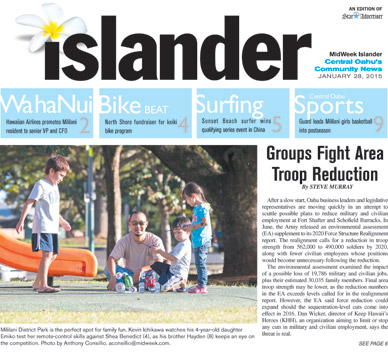Groups Fight Area Troop Reduction
After a slow start, Oahu business leaders and legislative representatives are moving quickly in an attempt to scuttle possible plans to reduce military and civilian employment at Fort Shafter and Schofield Barracks. In June, the Army released an environmental assessment (EA) supplement to its 2020 Force Structure Realignment report. The realignment calls for a reduction in troop strength from 562,000 to 490,000 soldiers by 2020, along with fewer civilian employees whose positions would become unnecessary following the reduction.
The environmental assessment examined the impact of a possible loss of 19,786 military and civilian jobs, plus their estimated 30,035 family members. Final area troop strength may be lower, as the reduction numbers in the EA exceeds levels called for in the realignment report. However, the EA said force reduction could expand should the sequestration-level cuts come into effect in 2016. Dane Wicker, director of Keep Hawaii’s Heroes (KHH), an organization aiming to limit or stop any cuts in military and civilian employment, says the threat is real.
“Looking at the reports and talking to people who work in the congressional arena and the Army, they are faced with budget cuts,” said Wicker. “The sequestration was real and the Army has to make cuts.”
Those cuts would result in an estimated loss of 26,776 associated jobs (4.3 percent of Oahu’s population), plus an annual reduction of $1.3 billion in spending and $9.2 million in sales-tax receipts, according to the environmental assessment.
“I have spoken with businesses in Wahiawa and Mililani, and when soldiers are on deployment, overnight they lose 30 percent of their business,” said Wicker. “That’s a temporary deployment. If it is permanent, businesses will close their doors.”
The EA looked at 14 areas of impact ranging from biological and cultural resources, to the economy and transportation. A loss of nearly 20,000 direct military and civilian employees on Oahu was determined to have a significant socioeconomic impact, while a reduction would benefit nearly every other category.
To gather information and testimony about the impact of a possible troop reduction, the Army is leading two Listening Sessions at 6:30 p.m. Jan. 27 at Hale Koa Hotel and Jan. 28 at Leilehua High School.
“They want to see everything the Army touches — partnerships, economy, community projects, what they do with our schools,” said Wicker, who stressed the sessions are the last chance for the community to impact the Army’s decision.
As of Jan. 21, KHH collected more than 26,000 petition signatures supporting current troop and civilian employment numbers. Petition gathering closed Jan. 26. The signatures are critical, as the number of supporting documents has lagged those for other bases recommended for cuts.
According to KHH, Fort Polk, La., generated 17,000 letters of support, as opposed to just 30 for Oahu’s Army bases.
“It is our fault, as residents of Hawaii,” said Wicker, who notes the late Sen. Daniel Inouye’s impact on maintaining the state’s military funding. “I think we got too comfortable and we depended on our congressional delegation to weigh in to minimize any significant repositioning here at our military installations.”






